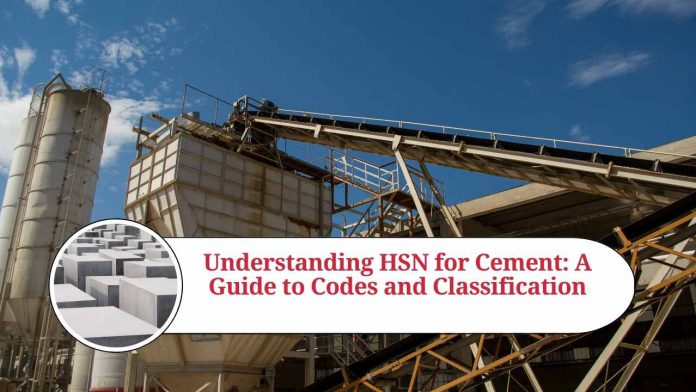Understanding HSN for Cement: A Guide to Harmonized System of Nomenclature
The Harmonized System of Nomenclature (HSN) is a globally accepted system of classifying goods for international trade. It is used to harmonize the classification of products and facilitate trade negotiations and agreements between countries. HSN for cement is a specific classification that is used to identify and classify different types of cement for import and export purposes. In this blog, we will explain what HSN for cement is, why it is important, and how it works.
What is HSN for Cement?
HSN for cement is a specific classification system that is used to identify and classify different types of cement for import and export purposes. It is a six-digit code that is used to categorize cement products based on their composition, quality, and intended use. The HSN code for cement is 2523.
Why is HSN for Cement Important?
HSN for cement is important for several reasons. First, it helps to facilitate trade between countries by providing a standardized system of classification. This makes it easier for importers and exporters to identify and classify cement products correctly, which can help to avoid delays and reduce costs.
Second, HSN for cement is important for regulatory purposes. Many countries have specific regulations regarding the import and export of cement products, and these regulations often require the use of HSN codes. By using the correct HSN code for a particular type of cement, importers and exporters can ensure that they are in compliance with these regulations.
Finally, HSN for cement is important for statistical purposes. Governments and international organizations use HSN codes to track the flow of goods between countries and to gather data on trade patterns and trends. By using HSN codes, they can generate accurate and reliable statistics on the import and export of cement products.
How Does HSN for Cement Work?
HSN for cement works by using a six-digit code to classify cement products based on their composition, quality, and intended use. The first two digits of the code (25) indicate that the product is a mineral product. The third digit (2) indicates that the product is a type of cement. The remaining three digits are used to classify the product based on its specific properties and intended use.
For example, the HSN code for Portland cement is 2523 29 10. The first two digits (25) indicate that the product is a mineral product. The third digit (2) indicates that the product is a type of cement. The remaining three digits (329) are used to classify the product based on its specific properties and intended use. In this case, the code 329 indicates that the cement is Portland cement.
Here are some additional details about HSN for cement that might be useful:
Different Types of Cement and Their HSN Codes
There are many different types of cement, and each type has a specific HSN code. Here are some examples:
- Portland cement: 2523 29 10
- White cement: 2523 21 00
- Colored cement: 2523 10 00
- Hydraulic cement: 2523 90 20
- Aluminous cement: 2523 90 30
- Slag cement: 2523 90 40
- Pozzolanic cement: 2523 90 50
- Super sulfate cement: 2523 90 60
As you can see, each type of cement has a unique code that reflects its composition, quality, and intended use.
HSN Codes for Cement Products and Accessories
In addition to codes for different types of cement, there are also HSN codes for various cement products and accessories. Here are some examples:
- Cement clinkers: 2523 10 00
- Cement bricks: 6810 11 90
- Cement tiles: 6907 22 00
- Cement pipes: 6810 11 90
- Cement bags: 3923 21 00
- Cement mixers: 8474 31 00
As with cement types, each of these products and accessories has a specific code that reflects its composition, quality, and intended use.
How to Determine the HSN Code for Your Cement Products
If you are involved in the import or export of cement products, it is important to determine the correct HSN code for your products. To do this, you should consult the official HSN list for your country or region. This list will provide you with the codes for different types of cement and cement products, as well as any applicable rules and regulations.
It is important to note that the HSN system is subject to change, so it is a good idea to stay up to date on any updates or revisions to the system. By doing so, you can ensure that you are using the most current and accurate codes for your cement products.
Conclusion
In conclusion, understanding HSN for cement is essential for anyone involved in the import or export of cement products. By using the correct codes, you can ensure that you are in compliance with regulations, facilitate trade between countries, and generate accurate statistics on the flow of goods. With the information and resources available, determining the correct HSN code for your cement products is a straightforward process that can help to streamline your business operations and ensure your products reach their intended destination.
Read more useful content:
Frequently Asked Questions (FAQs)
- What is HSN for cement?
HSN (Harmonized System of Nomenclature) is a system of codes used to classify goods for import and export purposes. HSN for cement is a set of codes used to classify different types of cement and cement products.
- Why is HSN important for cement?
HSN is important for cement because it helps to facilitate trade between countries and ensure compliance with regulations. By using the correct HSN codes, importers and exporters can avoid delays and penalties, and accurate statistics can be generated on the flow of goods.
- How are HSN codes for cement determined?
HSN codes for cement are determined based on the composition, quality, and intended use of the cement or cement product. Each type of cement and cement product has a unique code that reflects these factors.
- How do I determine the HSN code for my cement products?
To determine the HSN code for your cement products, you should consult the official HSN list for your country or region. This list will provide you with the codes for different types of cement and cement products, as well as any applicable rules and regulations.
- What are some examples of cement products that have HSN codes?
Examples of cement products that have HSN codes include cement clinkers, cement bricks, cement tiles, cement pipes, cement bags, and cement mixers.
- Are HSN codes for cement the same in all countries?
No, HSN codes for cement may vary between countries, depending on local regulations and trade agreements.
- What are the benefits of using HSN for cement?
The benefits of using HSN for cement include facilitating trade, ensuring compliance with regulations, and generating accurate statistics on the flow of goods.
- Can I use the same HSN code for all types of cement products?
No, each type of cement product has a unique code that reflects its composition, quality, and intended use.
- What happens if I use the wrong HSN code for my cement products?
Using the wrong HSN code for your cement products can result in delays, penalties, and other legal issues. It is important to consult the official HSN list and ensure that you are using the correct code.
- How often do HSN codes for cement change?
HSN codes for cement may change periodically, depending on updates to the system or changes in local regulations. It is important to stay up to date on any revisions to the HSN system to ensure that you are using the most current and accurate codes.




















